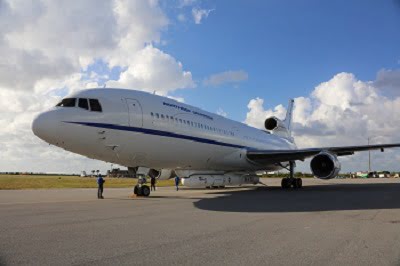Photonics Handbook
NASA’s ICON Satellite Begins Study of Ionosphere
NASA’s Ionospheric Connection Explorer (ICON) satellite launched at 9:59 p.m. EDT Oct. 10 from the Kennedy Space Center.

Northrop Grumman’s L-1011 Stargazer aircraft carrying the Pegasus XL rocket with NASA’s Ionospheric Connection Explorer (ICON) satellite. Courtesy of Northrop Grumman.
Now successfully located within the ionosphere, the satellite will study wind speeds, directions, and temperatures within the critical altitude zone between 90 and 300 km to gain a better picture of the weather patterns occurring within that space. The satellite aims to further the understanding of interactions between the region where Earth’s weather and space weather meet.
One of the central components of the satellite’s instrument package is the Michelson Interferometer for Global High-Resolution Thermospheric Imaging (MIGHTI), which was developed by the Naval Research Laboratory and Jenoptik, which built the imaging optics.
MIGHTI represents a significant advancement in Michelson interferometer design. Ordinarily, interferometers have a single mirror attached to an adjustable motorized bracket. The mirror is moved and a reading is taken; then the mirror is moved again and another reading is taken, and so on. Because the device will be launched into space on a rocket, the delicate moving interferometer parts have been replaced by fixed tilted gratings, resulting in a robust, monolithic element known as a Doppler Asymmetric Spatial Heterodyne (DASH) interferometer. In this design, each grating groove acts as a mirror, so the device can take measurements without the need for precision adjustment.
“Our initial data shows the spacecraft is in good health and performing as expected,” said Steve Krein of Northrop Grumman, vice president of civil and commercial satellites.
The satellite was attached to a Northrop Grumman Pegasus XL rocket aboard the company’s L-1011 Stargazer aircraft. Once the aircraft reached 39,000 feet, the rocket was dropped, with ignition occurring five seconds afterward.
NASA and Northrop Grumman originally targeted a 9:30 p.m. drop, but due to a loss of communication between ground teams at Cape Canaveral Air Force Station and the aircraft, the first drop attempt was bypassed.
“When your launch pad is moving at 500 to 600 miles per hour, things happen,” said Omar Baez, launch director in NASA’s Launch Services Program. “The first attempt got us because we lost positive communication with the aircraft and the ground, and our rule is to abort the flight and go back around and try it again. And we were able to execute it flawlessly.”
The ICON satellite will orbit Earth at a 27° inclination at an altitude of 575 km, placing it in position to observe the ionosphere around the equator, one of the most problematic areas for technology passing through.
For more about NASA’s ICON mission, visit www.nasa.gov/icon.
/Buyers_Guide/Jenoptik_Optical_Systems_GmbH_Optical_Systems/c17723
/Buyers_Guide/Northrop_Grumman_Aerospace_Systems/c10469